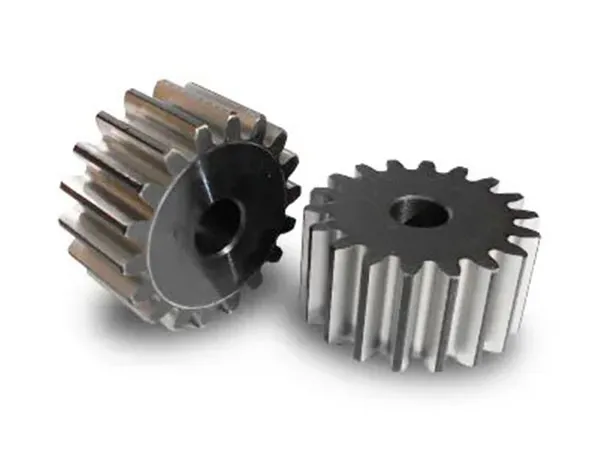- +86 13837949030 +86 15890619536
- info@lymcbearings.com export@lymcbearings.com
- Luoxin Industrial Cluster, Luoyang City,Henan Province,China

Spur gears are the most common type of gears used in mechanical systems to transmit power and motion between parallel shafts. They are characterized by their straight teeth, which are parallel to the gear's axis of rotation. Spur gears are simple, efficient, and cost-effective, making them widely used in various applications ranging from simple machinery to complex industrial systems. Spur gears have straight, parallel teeth cut along the circumference of the gear. This design allows for efficient power transmission between parallel shafts. Common materials for spur gears include steel, cast iron, brass, bronze, plastic, and other composites. The choice of material depends on the application's load capacity, operating environment, and cost considerations. Spur gears are fundamental components in many mechanical systems due to their simplicity, efficiency, and versatility. Proper selection, installation, and maintenance are key to ensuring optimal performance and longevity in various applications.
Spur gears are one of the most commonly used types of gears in mechanical systems, characterized by their straight, parallel teeth that are cut along the surface of a cylindrical gear blank. These gears are typically used for transmitting power between parallel shafts and are known for their simplicity, reliability, and efficiency in a wide range of applications.
Straight Teeth: Spur gears have teeth that are straight and parallel to the gear's axis. This allows them to mesh smoothly with other spur gears on parallel shafts.
Simple Design: Spur gears are relatively simple in design and easier to manufacture compared to other types of gears, making them cost-effective.
High Efficiency: Due to their straightforward design, spur gears have high efficiency, typically up to 98-99%, as they do not experience significant sliding friction during operation.
No Axial Thrust: Unlike helical gears, spur gears do not produce axial thrust forces, which simplifies the bearing arrangements and reduces maintenance.
Spur gears work by meshing two gears together to transmit torque and rotational motion from one shaft to another. The teeth of the driving gear push against the teeth of the driven gear, causing it to rotate. The contact between the teeth is instantaneous and occurs along a single line of action, making spur gears efficient for power transmission.
External Spur Gears:
Characteristics: The most common type, with teeth cut on the outer surface of a cylindrical blank. When two external spur gears mesh, they rotate in opposite directions.
Applications: Widely used in gearboxes, machinery, clocks, and automotive applications.
Internal Spur Gears:
Characteristics: Have teeth cut on the inner surface of a ring or annulus, allowing them to mesh with external gears. When an internal and external spur gear mesh, they rotate in the same direction.
Applications: Used in planetary gear systems, differential drives, and compact gear arrangements.
Rack and Pinion:
Characteristics: A rack is a flat, straight gear with teeth, while a pinion is a small spur gear that meshes with it. This arrangement converts rotational motion into linear motion.
Applications: Commonly used in automotive steering systems, linear actuators, and rail systems.
Gearboxes and Transmissions: Used in automotive transmissions, industrial machinery, and power tools to transmit motion and adjust speed and torque.
Clocks and Watches: Essential components in timekeeping mechanisms, where precision and reliability are critical.
Conveyor Systems: Employed in conveyor belts and material handling systems for power transmission and speed control.
Mechanical Devices: Used in various small mechanical devices like printers, washing machines, and elevators.
Robotics and Automation: Spur gears are used in robotic arms, actuators, and other automated systems that require precise motion control.
High Efficiency: Spur gears have minimal energy loss due to friction, making them highly efficient for power transmission.
Simple Design and Manufacturing: Easy to design, produce, and assemble, resulting in lower manufacturing costs.
No Axial Load: Spur gears generate no axial thrust forces, which simplifies bearing arrangements and reduces the need for specialized thrust bearings.
Reliable and Durable: Spur gears are robust and can operate effectively in a wide range of conditions, including high loads and speeds.
Versatility: Available in various sizes, materials, and configurations to suit different applications and operational requirements.
Material Selection: Gears must be made from materials that can withstand the operating conditions, such as steel, cast iron, or composites.
Tooth Profile and Pitch: The tooth profile, pitch, and number of teeth should be designed to meet specific torque, speed, and load requirements.
Lubrication and Cooling: Proper lubrication is crucial to reduce friction, wear, and heat generation during operation.
Alignment and Backlash: Proper alignment and control of backlash (the small gap between meshing teeth) are essential for smooth operation and to avoid wear.